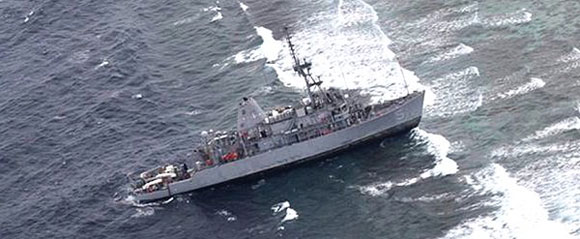
USS Guardian on Tubbataha Reef Photo:AP
In 2005, when the Greenpeace flagship, Rainbow Warrior, ran aground on Tubbataha Reef in the Sulu Sea, the captain claimed that the reef was incorrectly plotted on his charts. As reported by the UK’s Guardian in November 1, 2005:
Red Constantino of Greenpeace Southeast Asia blamed the incident on a maritime chart that showed that the Rainbow Warrior was supposed to be 1 ½ miles away from the reef when it ran aground. He said within minutes of the incident, Greenpeace contacted the marine park ranger station. “This accident could have been avoided if the chart was accurate,” he said. “We feel responsible, however.”
It appears that the charts may not have been corrected in the intervening seven years, as the US Navy is now also blaming the Thursday morning grounding of the USS Guardian on Tubbataha Reef on inaccurate charts.
US Navy: Ship stuck in Philippines used faulty map
“The Navy said in a statement that a review of Digital Nautical Charts, which are used for safe navigation by all U.S. Navy ships, found they contained inaccurate data and may have been a factor in the Guardian’s grounding. As a result, Navigator of the Navy Rear Adm. Jonathan White released precautionary guidance to all Pacific Fleet ships, saying that “initial review of navigation data indicates an error in the location of Tubbataha Reef” in the Philippines.”
The USS Guardian is reported to still be stuck on a reef in the Philippines’ Tubbataha National Marine Park. All all 79 crew members were reported to have been transferred to the support vessels USNS Bowditch (T-AGS 62) and MSV C-Champion after unsuccessful efforts to free the Guardian on high tide.

Bear in mind that some areas of the Philipppines have not been re-surveyed for 80 years, NAMRIA, the national mapping agency only has two survey ships – inadequate for the area to be covered and a joint US-Philippines survey project was hampered after a shooting incident in 2008.
But it isn’t just a problem in the Philippines – a jack-up barge grounded in Orkney Islands in waters not surveyed since 1840.
Those interested in the incident and the situation might like a briefing we prepared at at MAC: http://wp.me/pxyhm-4Xi
Excellent article in the Marine Accident Casebook. Thanks. There are several interesting aspects to this incident. First, the grounding of the Rainbow warrior on the same reef seven years ago, allegedly due in part to bad charting, should have provided some warning. Given the level of naval traffic in and around Philippine waters and the ongoing territorial disputes in the region, checking the charts might not be a bad idea. The technology has also changed. NAMRIA may only have two ships, but anyone with Google Earth can spot check satellite photos against existing charts. Strictly speaking, the USS Guardian was relying on DNC charts. I wonder if there is any reliable way to automate comparing satellite surveys against existing charts. I note that the Navigator of the Navy Rear Adm. Jonathan White has released “precautionary guidance” to all Fleet and ship commanders “to operate with caution when using NGA-supplied Coastal Digital Nautical Charts due to an identified error in the accuracy of charting in the Sulu Sea.”
The MCM Class ships are non-magnetic minesweepers:
The mechanical equipment had to be made from aluminum or Austenitic Stainless steel ir order to meet the magnetic signature design requirements.
The Engines came from Italy, and while they met the Magnetic requirments there were some issues regarding their direction of Rotation, something got mixed up.
The chart, paper or electronic, may certainly have been incorrect. On my first time to the Caribbean in the 1980s, the Admiralty chart for Antigua contained the legend: “Caution. The island of Antigua may lie 1.5 NM west of it’s charted position”. So chart errors are not unknown.
However, one should consider the number of people on a US Navy bridge underway. What were they all doing, in pilotage waters? No doubt taking radar bearings, gyro bearings, and reporting all to the plotter, in very efficient Navy fashion. But was anyone watching the fathometer?
@eastriver – fathometer?? Am I to assume you are an armchair sailor?
Once you get out of the US, Europe, a few ports in Russia and the big ports in China, most of the charts – and a whole lot of the blue-water charts – were last updated (or created) by the British under sail.
Until the late 1990s, or early 2000s there was a island in the Bahamas, which on the best available chart had a note to the effect: The island is reported to be 2 nautical miles north of its charted position.
To assume that the charts of the middle of the Pacific are as up-to-date as the map your GPS uses to get you to the nearest Starbucks is naive.